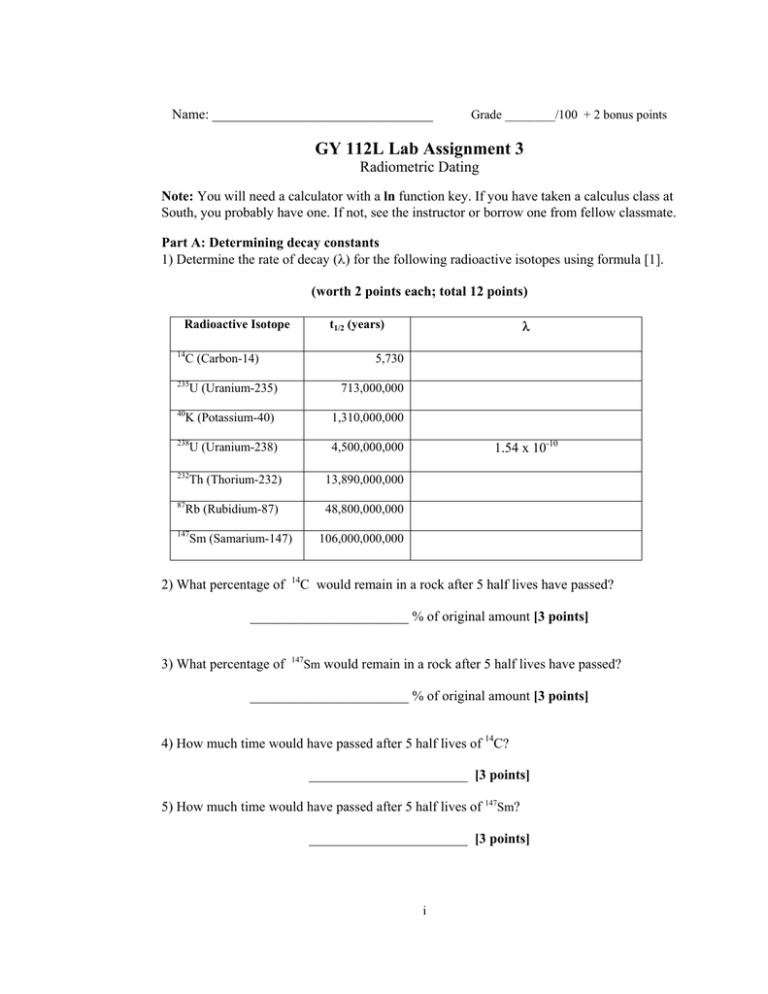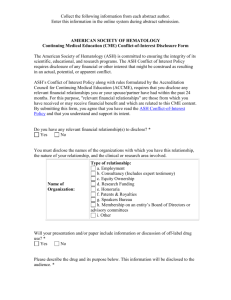GY 112L Lab Assignment 3 Radiometric Dating
advertisement

Name: ________________________________ Grade ________/100 + 2 bonus points GY 112L Lab Assignment 3 Radiometric Dating Note: You will need a calculator with a ln function key. If you have taken a calculus class at South, you probably have one. If not, see the instructor or borrow one from fellow classmate. Part A: Determining decay constants 1) Determine the rate of decay (λ) for the following radioactive isotopes using formula [1]. (worth 2 points each; total 12 points) Radioactive Isotope 14 C (Carbon-14) 235 40 5,730 U (Uranium-235) 713,000,000 K (Potassium-40) 1,310,000,000 238 U (Uranium-238) 4,500,000,000 232 Th (Thorium-232) 13,890,000,000 Rb (Rubidium-87) 48,800,000,000 87 147 Sm (Samarium-147) 2) What percentage of λ t1/2 (years) 1.54 x 10-10 106,000,000,000 14 C would remain in a rock after 5 half lives have passed? _______________________ % of original amount [3 points] 3) What percentage of 147 Sm would remain in a rock after 5 half lives have passed? _______________________ % of original amount [3 points] 4) How much time would have passed after 5 half lives of 14C? _______________________ [3 points] 5) How much time would have passed after 5 half lives of 147Sm? _______________________ [3 points] i Part B: Determining radiometric dates on stratigraphic sections The following diagram is a schematic stratigraphic section that summarizes the thickness and order of fictitious rocks exposed in a fictitious mountain. You will see stratigraphic sections several times in this class as they are the most effective way of illustrating vertical rock associations. All of the questions in this exercise refer to this section. After studying the section, you observed 7 volcanic ash beds and determined that they are suitable for radiometric dating. They contain high concentrations of zircon (ZrSiO4), a mineral that contains U as a trace element. You opt to date each of the beds using the 235 U/207Pb method. ii 1) You need to determine Do for the ash beds. Since they have the same overall composition, you are going to assume that all 7 ash beds have the same value of Do (This is not absolutely correct, but an okay assumption for a GY 112 class). You arrange to have 3 samples of ash bed 1 analyzed for 235U and 207Pb. The following data came back from the lab: N (235U/237U) 3.005 D (207Pb/237U) 1.002 4.789 1.150 1.211 0.8505 D (Daughter atom ratio) Isochron Diagram 1.5 1.45 1.4 1.35 1.3 1.25 1.2 1.15 1.1 1.05 1 0.95 0.9 0.85 0.8 0.75 0.7 0 1 2 3 4 5 N (Parent atom ratio) Using the figure above, determine Do _______________________________ [6 points] iii 2) The analyses that you requested have just returned from the laboratory and comprise part of the table below. Using the methodology outlined in the example exercise at the start of this lab, determine the age of each of the ash beds [35 points] N (235U/237U) D (207Pb/237U) Ash Bed 1 0.1352 0.4879 2 0.1822 0.4199 3 0.2286 0.3630 4 0.0494 0.6751 5 0.0430 0.6919 6 0.1867 0.5523 7 0.3522 0.4361 Age (years) 2) A granite unconformably underlies the layered rock sequence that contains the ash beds. What kind of unconformity is it? _______________________________________ [2 points] 3) You also date the granite dated using 238U/206Pb. The relevant data are below. What age do you get? [5 points] Method U/Pb Do 0.8563 N 1.386 D Age (years) 0.4959 1.410 x 109 (1.41 Ga) K/Ar 4) Several years ago, the same granite was dated using 40K/40Ar and the date obtained was 1.41 GA (see table above). This is not the same as the date you should get. Why? It is NOT because of any error in either method. This is an interpretation question so THINK about it before you seek help. (Hint: Consider the physical states of the daughter isotopes. How does argon (Ar) differ from lead (Pb)?) ____________________________________________________________________ ____________________________________________________________________ ____________________________________________________________________ ____________________________________________________________________ ____________________________________________________________________ ____________________________________________________________ [5 points] iv 5) Given the 40K/40Ar age of the granite and the age of the first ash bed which overlies the granite, how much is the time gap represented by the first unconformity? ____________________________________ [3 points] 6) How much is the time gap represented by the second unconformity ____________________________________ [3 points] Part C: Applications Here is a neat application of absolute dating that geologists find invaluable. If you can date layers within a sedimentary sequence, you can determine the rate of sedimentation between those layers. As an example, consider the following sketch: It shows two ash beds within a stratigraphic section that have both been dated. There is 50,000 years between them and they are 25 meters apart (vertically). This means that 25 meters of sediment were deposited within 50,000 years. The sedimentation rate can be worked out very easily: Rate = 25 meters ÷ 50,000 years = 0.0005 m/year. Geologists would rewrite this as 0.5 mm/year. 1) Refer back to the stratigraphic section you looked at previously. Determine the sedimentation rate between: the base of ash bed 1 to the base of ash bed 2: ____________ mm/year the base of ash bed 3 to the base of ash bed 4: ____________ mm/year the base of ash bed 4 to the base of ash bed 5: ____________ mm/year the base of ash bed 5 to the base of ash bed 6: ____________ mm/year [3 points each; 12 points total] v Name: ___________________________ 2) How has the rate of sedimentation changed from the bottom of the sedimentary section (ash bed 1) to the top (ash bed 6)? ____________________________________________________________________ ____________________________________________________________________ ____________________________________________________________________ ____________________________________________________________________ ____________________________________________________________________ ____________________________________________________________ [5 points] Bonus exercise: An amateur paleontologist walks into your office with a bone claiming that it came from a dinosaur that he uncovered in his backyard. You get the bone analyzed for 14C and get the following data: D=0.3234; N=0.0233. Is it from a dinosaur? Why or why not? ____________________________________________________________________ ____________________________________________________________________ ____________________________________________________________________ ____________________________________________________________________ ____________________________________________________________________ ______________________________________________________ [2 bonus points] vi





